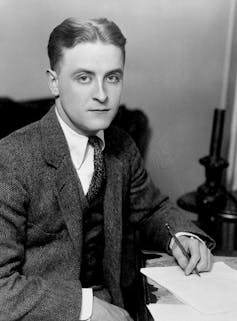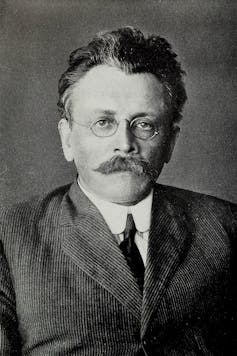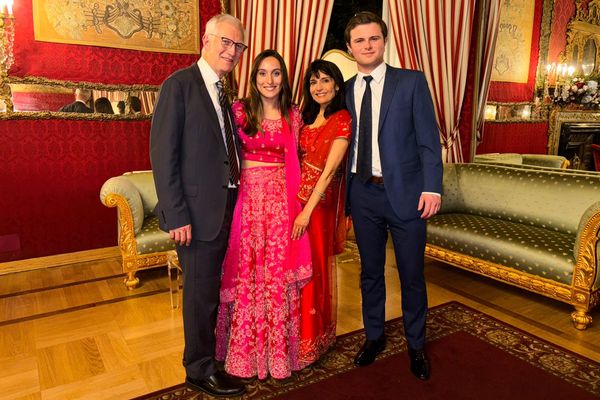One hundred years after its publication, F. Scott Fitzgerald’s third novel, The Great Gatsby – the story of nouveau riche Jay Gatsby’s obsessive quest to win back his lost love, Daisy Buchanan – is best remembered for its depiction of America’s Jazz Age excess, especially through Gatsby’s wildly extravagant parties.
Readers might also focus on moral questions raised about America’s class and racial divisions, the fundamental inequalities that hinder social progress, and the faulty-but-compelling promise of what a decade later was labelled “the American dream”. These are compelling themes within Fitzgerald’s tightly constructed and brilliantly expressed novel.
Yet for all of its emphasis on national concerns, the book also contains subject matter of more universal value.
A passage in the fifth chapter describes an incident during the reunion of Gatsby with the now-married Daisy at the cottage of Nick Carraway, the novel’s first-person narrator.
Amid awkward uncertainty about achieving his goal of repeating the past by winning Daisy back after five years apart, Gatsby leans his head backward and topples over “a defunct mantelpiece clock”, which he then just manages to catch before it would have smashed on the floor. This incident emphasises an important theme of the novel – a meditation on time and change.
This article is part of Rethinking the Classics. The stories in this series offer insightful new ways to think about and interpret classic books and artworks. This is the canon – with a twist.
On one level, the novel presents contrasts between an older, elite moneyed class and emerging groups that have embraced opportunities for success in the entertainment industries of film and theatre. A further social layer is those who have taken underground routes to riches through bootlegging alcohol or manipulating the bond market.
The socioeconomic and cultural transformations in the US after the first world war are amplified through references to modern technology. In particular, the telephone most often serves to disrupt conversations rather than promote improved communication. There are also Gatsby’s new automobiles, hydroplane, dazzling electric lighting displays and “a machine in the kitchen which could extract the juice of 200 oranges in half an hour”.
In contrast, Daisy’s husband, Tom, has turned a car garage on his Long Island estate into a stable for his riding horses. In turning the value of horses from work to leisure, he seems to reverse the flow of history.
Nick, though, is attracted to the dynamic potential for cultural change. He crosses into New York City over the Queensboro Bridge, a recently completed steel cantilever construction – the longest in the US at the time:
Anything can happen now that we’ve slid over this bridge, I thought; anything at all.
The “defunct mantelpiece clock” and its near demise could also represent Fitzgerald’s rejection of a literary inheritance. The author avoids the relative certainty of 19th-century realism’s character development and linear narrative chronology. Instead, he emphasises modernism’s fragmentation and ambiguity.
Time shifts and nature’s power
In the novel, Gatsby’s backstory is slowly and uncertainly revealed. Vital information about his youth is delayed until the final chapter. Born James Gatz on a poor North Dakota farm, the mysterious Jay Gatsby emerges through Nick’s memory.
Nick recounts conversations with Gatsby, hears rumours, speaks with others and reads newspaper reports about him. He also imagines a great deal, delivering scattered details and making conjectures in jumbled time. “He told me all this much later, but I’ve put it down here” is one example.

Some simple dialogue between Gatsby and Nick hints at the seemingly random, but actually carefully designed, narrative sequencing. Gatsby invites Nick to come along for a morning flight in his newly purchased hydroplane. “What time?” Nick asks, and the reply is: “Anytime that suits you best.”
The Great Gatsby’s fractured sense of time challenges literary convention. It also reflects a world in flux after the first world war, and the moral as well as economic adjustments of the roaring twenties. But another crucial and often undervalued aspect of the novel deserves further attention: the power of nature.
Natural imagery infuses the text, as the Sun and Moon, rain and wind, the stars and seasons counterbalance disorderly human time. A sense of cosmic, eternal time contends with the vanities of daily life and inevitable mortality.
Nick connects Gatsby’s inevitable death with nature’s cyclical movements:
He must have looked up at an unfamiliar sky through frightening leaves and shivered as he found what a grotesque thing a rose is and how raw the sunlight was upon the scarcely created grass. A new world, material without being real.
Besides being an example of Fitzgerald’s radiant prose, this passage is both a comment on the delusions of American ambition, and an assertion of nature’s timeless presence and enduring authority.
Beyond the canon
As part of the Rethinking the Classics series, we’re asking our experts to recommend a book or artwork that tackles similar themes to the canonical work in question, but isn’t (yet) considered a classic itself. Here is William Blazek’s suggestion:

The Rise of David Levinsky by Abraham Cahan (1917) chronicles the Jewish title character, starting with his early life in imperial Russia, where he devotes himself to religious study.
After emigrating to the US he abandons his spiritual calling and becomes a success in the garment industry. Yet despite his wealth, he is essentially unhappy and lonely.
Cahan, a Lithuanian-born Jewish American socialist, modelled his story on another rags-to-riches tale, The Rise of Silas Lapham by William Dean Howells (1885), which also contrasts American materialism with moral goodness.
William Blazek is professor emeritus at Liverpool Hope University and vice president of the F. Scott Fitzgerald Society. In 2025 the F. Scott Fitzgerald Society will hold its 17th biannual international conference from 22-28 June in New York City: A Fitzgerald Centennial: The Great Gatsby, New York, and New Perspectives. Visit https://fscottfitzgeraldsociety.org/
This article was originally published on The Conversation. Read the original article.







